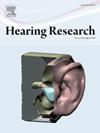Cochlear implantation with a dexamethasone-eluting electrode array: First-in-human safety and performance results
IF 2.5
2区 医学
Q1 AUDIOLOGY & SPEECH-LANGUAGE PATHOLOGY
引用次数: 0
Abstract
Cochlear implantation is the standard of care for individuals with severe-to-profound sensorineural hearing loss. However, implantation itself can degrade residual hearing, for example due to insertional trauma and subsequent inflammatory processes. One potential method to mitigate this loss of residual hearing is through the local and sustained delivery of anti-inflammatory drugs released from the electrode array. To this end, a dexamethasone eluting electrode array (FLEX28 DEX) was developed by MED-EL.
Here we present the results from a first-in-human feasibility study of the CIDEXEL system (the Mi1200 SYNCHRONY cochlear implant combined with the FLEX28 DEX array). A single-arm, exploratory, open-label, prospective, longitudinal, and monocentric study design with sequential block enrolment was used. Nine participants were implanted with the CIDEXEL and were followed up to 9 months post first fitting. The primary aim was to evaluate the safety of the device. The secondary aims were to assess: 1) electrode impedance levels; 2) hearing preservation rates; 3) speech perception outcomes; and 4) subjective feedback from the surgeons regarding their experience with the device during the operation.
There were no device- or procedure-related serious adverse events. Low and stable impedance levels were observed across all electrode sites (basal, medial and apical). In the majority of participants, good preservation of residual hearing (≤15 dB hearing loss) was achieved. The participants showed speech perception test results which were comparable to those with a non-eluting FLEX28 array. Surgeons reported that the CIDEXEL had similar handling and insertion properties to a conventional electrode array.
地塞米松洗脱电极阵列人工耳蜗植入:首次人类安全性和性能结果
人工耳蜗植入术是重度到重度感音神经性听力损失患者的标准治疗方法。然而,植入本身会降低残余听力,例如由于植入创伤和随后的炎症过程。减轻残余听力损失的一种潜在方法是通过局部和持续地递送从电极阵列释放的抗炎药物。为此,MED-EL开发了地塞米松洗脱电极阵列(FLEX28 DEX)。在此,我们介绍了CIDEXEL系统(Mi1200 SYNCHRONY人工耳蜗与FLEX28 DEX阵列结合)首次人体可行性研究的结果。采用单臂、探索性、开放标签、前瞻性、纵向、单中心、顺序分组入组的研究设计。9名参与者植入了CIDEXEL,并在首次装配后随访9个月。主要目的是评估该装置的安全性。次要目的是评估:1)电极阻抗水平;2)听力保存率;3)语音感知结果;4)外科医生对手术过程中设备使用体验的主观反馈。没有器械或手术相关的严重不良事件。低而稳定的阻抗水平在所有电极部位(基部、中部和根尖)观察到。在大多数参与者中,获得了良好的残余听力保护(听力损失≤15 dB)。参与者的语音感知测试结果与那些使用非洗脱型FLEX28阵列的人相当。外科医生报告说,CIDEXEL具有与传统电极阵列相似的操作和插入特性。
本文章由计算机程序翻译,如有差异,请以英文原文为准。
求助全文
约1分钟内获得全文
求助全文
来源期刊

Hearing Research
医学-耳鼻喉科学
CiteScore
5.30
自引率
14.30%
发文量
163
审稿时长
75 days
期刊介绍:
The aim of the journal is to provide a forum for papers concerned with basic peripheral and central auditory mechanisms. Emphasis is on experimental and clinical studies, but theoretical and methodological papers will also be considered. The journal publishes original research papers, review and mini- review articles, rapid communications, method/protocol and perspective articles.
Papers submitted should deal with auditory anatomy, physiology, psychophysics, imaging, modeling and behavioural studies in animals and humans, as well as hearing aids and cochlear implants. Papers dealing with the vestibular system are also considered for publication. Papers on comparative aspects of hearing and on effects of drugs and environmental contaminants on hearing function will also be considered. Clinical papers will be accepted when they contribute to the understanding of normal and pathological hearing functions.
 求助内容:
求助内容: 应助结果提醒方式:
应助结果提醒方式:


